 Phylum
Cnidaria .
Phylum
Cnidaria .9400 species...3 classes..
 Phylum
Cnidaria .
Phylum
Cnidaria .
9400 species...3 classes..
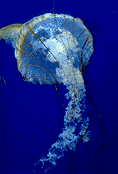
Class Hydrozoa..most primitive Many consist
of feathery or bushy colonies of tiny polyps. They are attached
to pilings, seaweed, shells and other surfaces. The Siphonophores
are hydrozoans in drifting colonies. Some polyps form floats,
others form long tentacles to capture prey. Portuguese man-of-war
is an example (Physalia).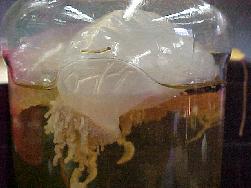
Class Scyphozoa...jelly fish has digestive
system is a set of radiating canals linking the central portion
to a peripheral ring.  Some mesogleas
can expel heavy chemical ions and replace them with lighter ones
to adjust buoyancy.
Some mesogleas
can expel heavy chemical ions and replace them with lighter ones
to adjust buoyancy.
 <--------Moon jelly (Aurelia aurita)------------->
<--------Moon jelly (Aurelia aurita)------------->Stomolophus meleagris Cannonball jelly fish (7/4/08 Cocoa Beach)
Class Anthozoa Corals and sea anemones only exist as polyps. The sea anemones always bear more than eight tentacles . Some burrow in mud but most dwell on a hard substratum, cemented there by secretions from a well differentiated disk.
Subclass Zoantharia are hard corals whose polyps are encased in a rigid calcium carbonate skeleton. Most hard corals live in colonies which are composed of vast numbers of small polyps (about 5mm) but can be larger in solitary forms. Most are subtropical or tropical in distribution. In colonial forms, the polyps are interconnected laterally forming a living sheet overlying the skeleton. Corals exhibit a great diversity in growth forms, ranging from delicately branching species to those whose massive skeletal deposits form the building blocks of the reef. On type, Meandrrina, the polyps are arranged continuously in rows, resulting in production of a skeleton with longitudinal fissures, a feature which accounts for its name, brain coral.
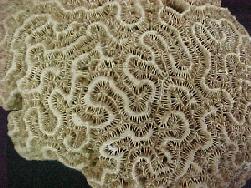 There is an order related to the hard corals without
a skeleton that are anemones which can cover rock faces. The
black or thorny corals form a slender, plant-like colonies
arranged around a horny axial skeleton and possess numerous
thorns.
There is an order related to the hard corals without
a skeleton that are anemones which can cover rock faces. The
black or thorny corals form a slender, plant-like colonies
arranged around a horny axial skeleton and possess numerous
thorns.
Octocorallian corals have eight featherlike tentacles and an internal skeleton like structure. These include the horny corals, sea whips and fans and red coral. Most of these have ancestral rod composed of organic material around which is draped the coenenchyme and polyps, the former containing spicules which impart a vivid coloration and form the spines of the red coral which is used in jewelry.
Cubozoans
In the class Cubozoa, which includes box jellies and sea wasps, the medusa is box-shaped and has complex eyes. (video of box jelly swimming)
To trap prey, cnidarians normally employ stinging cells which are discharged (under nervous control?) sometimes exposing barbs and frequently contain a toxin that can enter the body of the prey. Some are extremely potent (sea wasps ) (Killer Jellyfish Story) and have killed humans...respiratory paralysis. Sea slugs are known to pirate Nematocysts (stinging cells) and use them for their own protection.
Comb Jellies Phylum: Ctenophora
About 90 species ...worldwide and marine distribution. 4cm to 1m in size..radial symmetry with eight rows of plates..fused cilia (comb) for locomotion.
CTENOPHORA
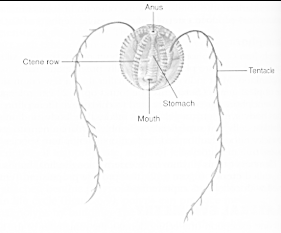 Both cnidaians and
ctenophores arose from the same basic stock with the presence of
nematocysts in one group of ctenophores (Euchlora rubra)
show that ctenophores may have arisen from a Medusa ancestor. The
order Cydippida is considered the most primitive and least
modified to the ctenophora plan.
Both cnidaians and
ctenophores arose from the same basic stock with the presence of
nematocysts in one group of ctenophores (Euchlora rubra)
show that ctenophores may have arisen from a Medusa ancestor. The
order Cydippida is considered the most primitive and least
modified to the ctenophora plan.
The basic structures that have guided the evolutionary development of the ctenophores are the arrangement of comb plates and general bi-radial symmetry. Modifications are found throughout the group.
As a group these ctenophores are very beautiful animals. Their glass-like transparency, delicate and the iridescence by day and luminescence at night have given them a distance beauty rarely found in the animal kingdom.
Fewer than 100 species have been described. They are
classified on the basis of their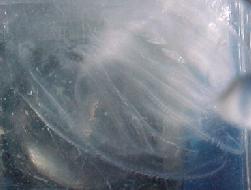
2 classes and 5 orders make up the phylum.
As mentioned, the body wall contains an outer epidermis, and inner endodermal epithelium with collenchyme (mesoglea) between containing true muscle cells. The mouth is at one end and sense organ at the other. On the surface of the body are 8 rows of comb plates arranged meridionally and equally spaced. They start at the sense organ and extend about 4/5ths of the distance to the oval pole. Each plate consists of a transverse row of fused cilia borne on modified ectodermal cells, the plates are arranged in succession and united as a ciliary's tract to form a complete comb-plate row. The cilia beat from one end to the other causing the animal to move with the mouth in the front though the direction of the wave is reversible. Some highly modified ctenophores like Cestum, the swimming action of the plates is supplemented by the sinuous movement of the ribbon like body.
Tentacles...most have 2, highly extensive usually longer than the body. Its made of mesoglea and longitudinal muscle strands and covered with epidermis. Lateral branches are covered with special adhesive cells (colloblasts or lasso cells). Each colloblast is composed of a sticky crescent-shaped body fastened by 2 filaments (derived from a flagellum). Food is captured by sticky colloblasts of the tentacles which are drawn over the mouth where ingestion of food occurs. The tentacles are also used as balancing organs while floating. The colloblast is considered a cell while the nematocyst of the cnidarians is an organelle of a cell.
Ctenophores are hermaphrodites and male and female gonads occur close to each other. Sometimes fertilization can occur internally but usually the sex cells are released into the sea water where fertilization occurs.
The comb jellies are the most remarkable form of swimming animals occupying an interesting evolutionary position between the radial symmetry of the hydroids and the true bilateral body form of the flatworms. Comb jellies are virtually all true plankton (drifters)-dwellers whose almost invisible transparent bodies drift in the oceans trailing tentacles like fishing lines. These are armed with lasso cells that explode and ensnare their microscopic prey.
The body has 3 layers, like the sea anemone and jellyfish, a mesoglea wedged between the thin outer ectodermal and endodermal layers. Most noticeable is the eight rows of plates of cilia (comb rows or comb plates called ctenes)) whose activities serve to propel the animal while it is searching for zooplankton prey (in a mouth forward position).
The most common genus (found in colder waters) Pleurobrachia, is about 4cm in diameter and has two pits which the tentacles are retracted into. The tentacles are used like drift nets, catching passing food. Once caught the prey is held by a sticky substance, secreted by the colloblasts, until transferred to the stomach following wiping the tentacles across the mouth. Its reported that when feeding on pipe fish smaller than itself, it plays them out the same way an angler tires out a hooked fish. Both jellyfish and ctenophores possess special equilibrium devices (STATOCYSTS) which are responsive to gravity and help them determine up from down. They are also luminescent.
Order Cydippida Pleurobrachia retain characteristics of larva until adult stage is attained...most typical and least modified ...globular or egg shaped, 2 tentacles, simple gastrovascular canals with no peripheral canal system...comb rows equal in length P. Hormiphora and Euchlora
Order Lobata Mnemiopsis body compressed and is helmet shaped..a large contractile lobe is founding each side causing the comb plates to be longer than the others. Tentacle sheaths of larva disappear during metamorphosis and adult has reduced tentacles.
Order Cestida Velamen ribbon shaped and get up to 1 m long East Coast, USA
Order Platyctenea Ctenoplana most highly modified of all have a creeping or sedimentary existence. Body is flattened...comb rows may or may not be present...testes open to the surface by a duct and pore. Posses tentacle sheaths and retractile tentacles as well as a statocyst.
Class Nuda without tentacles
Order Beroida Beroe Bell or cone shaped with no trace of tentacles or tentacle sheaths at any stage in their development. Wide mouthed from New England.
Killer
Down Under
1. How many people
have died in the last century from the BOX jelly stings?
(A) 30 (B) 60 (C)
65 (D)4
2. How quickly can
cube (box) jelly venom kill a human? (A)
several hours (B)
4 minutes or less (C) an hour
(D) it doesn't kill
3. How does the venom
affect the heart? (A) speeds
it up (B) only effects nerve cells
not heart (C) slows it down and
stops it
4. What is the
difference between a planulae and a polyp?
(A) planula are mobile and polyps are attached
(B) planula are attached and polyps are
mobile (C) polyps are adults and planula
are larva
5. Where were Chironex
medusa found in the wild? (A) close
to the mainland (B) in estuaries
and streams (C) up to 40 miles
offshore (D) a and b are correct
(E) b and c are correct.
6. How long does it
take for a box jelly to undergo metamorphosis?
(A) 12 days (B)
24 days (C) 6 years
(D) 4 hours
7. What causes the stinging cells to be triggered?
(A) stimulated by temperature changes
(B) stimulated by touch only (C)
stimulated by chemicals (D) b and c
are correct
8. Where in
9. What is a pedalium?
(A) tentacles (B)
mouth part (C) feeding appendage
(D) a live shrimp fed to cube jellies
10. What feeds off
box jellies? (A) Asian fishermen
(B) sea turtles (C)
Great White Sharks (D) Sea Snakes
<